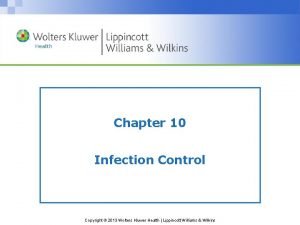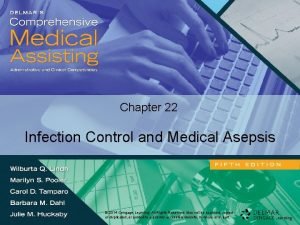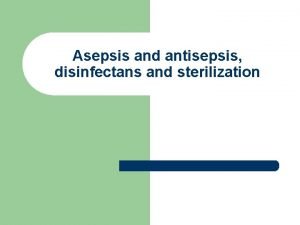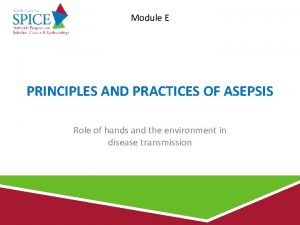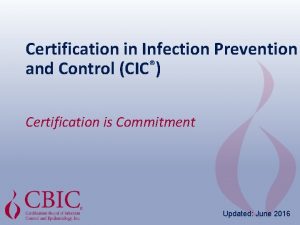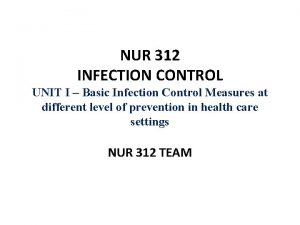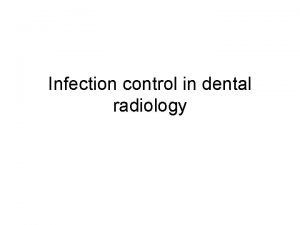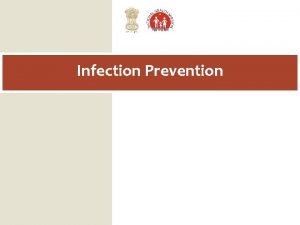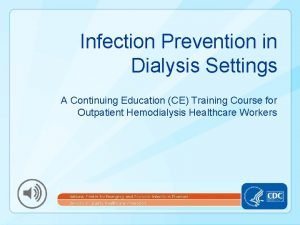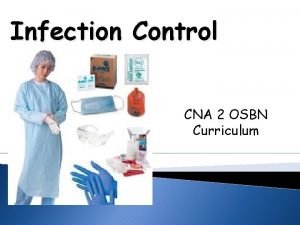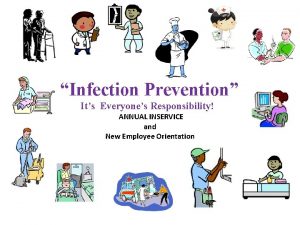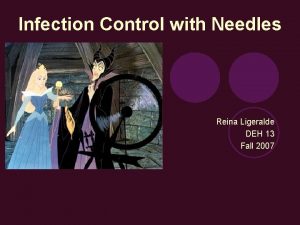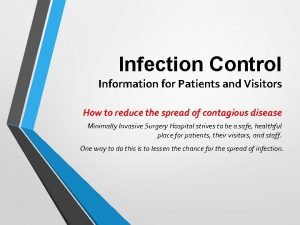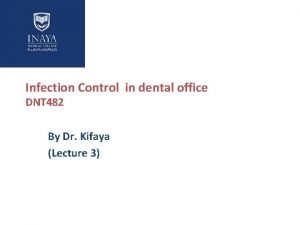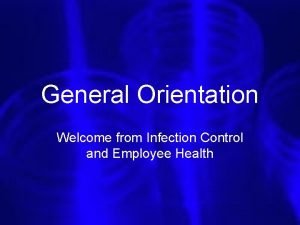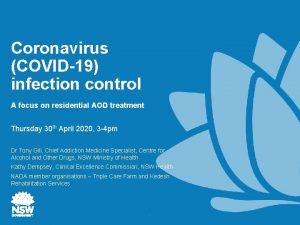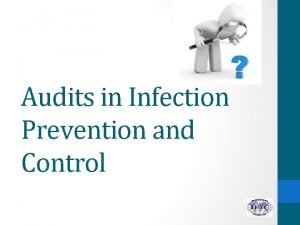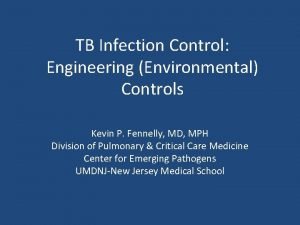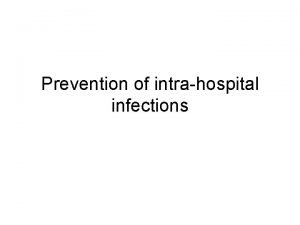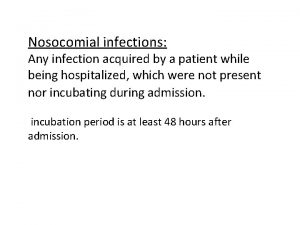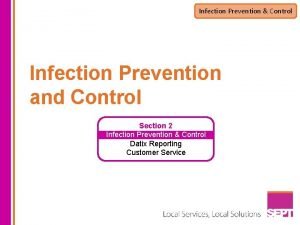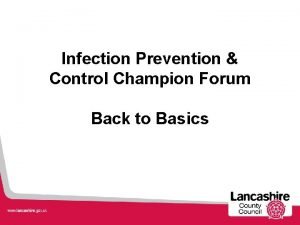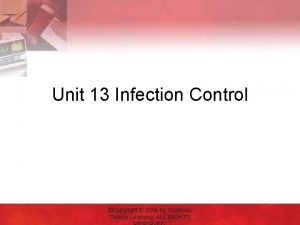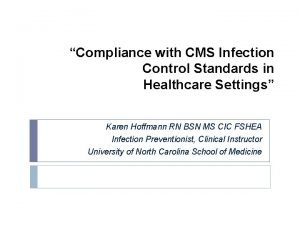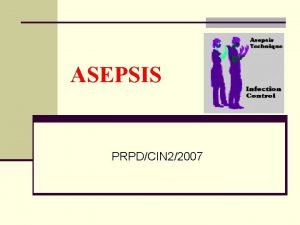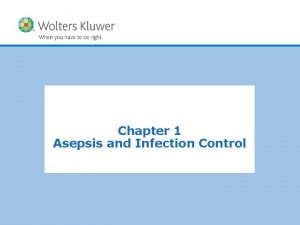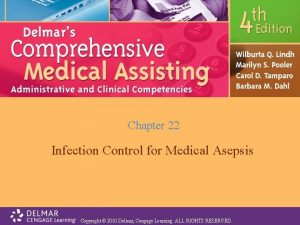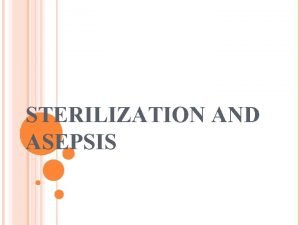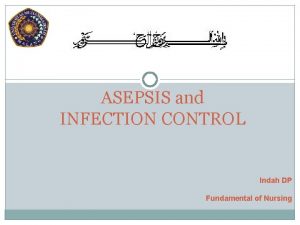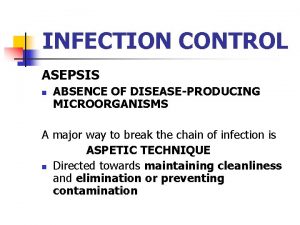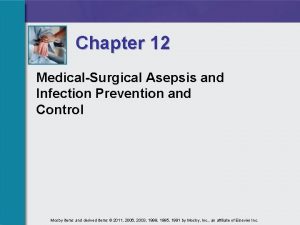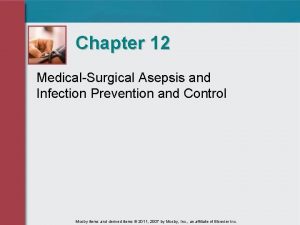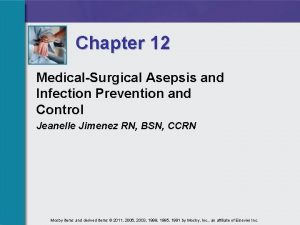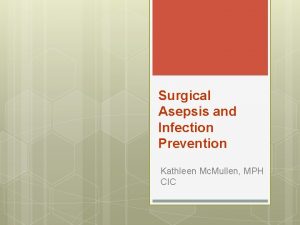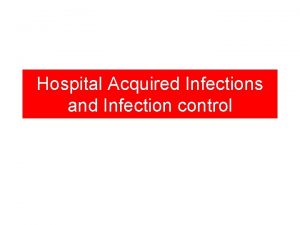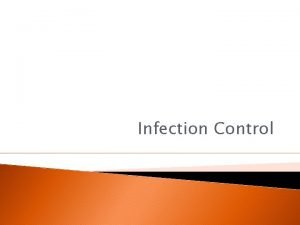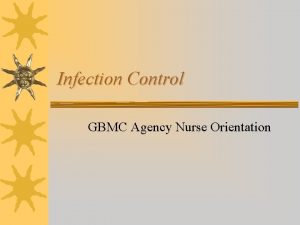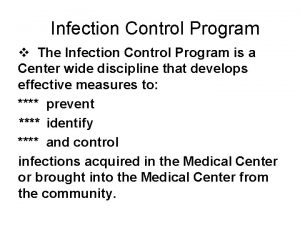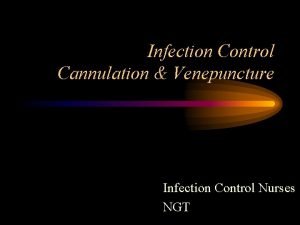Chapter 27 Asepsis and Infection Control Copyright 2011



































- Slides: 35

Chapter 27 Asepsis and Infection Control Copyright © 2011 Wolters Kluwer Health | Lippincott Williams & Wilkins

Objectives (pp. 3 & 4) • The Infection Concept is presented in this lecture. MRSA, VRE, Cellulitis, Shingles, C-Difficile, and UTI are the exemplars for the Infection Concept and are in a separate lecture. Copyright © 2011 Wolters Kluwer Health | Lippincott Williams & Wilkins

Nature of Infection • Infection—disease state resulting from the presence of pathogens in the body. May be acute or chronic • Pathogens are disease-producing microorganisms, such as bacteria, viruses, fungi, and parasites. • The presence of these pathogens usually produces an inflammatory response. Copyright © 2011 Wolters Kluwer Health | Lippincott Williams & Wilkins

Components of the Infection Cycle • Infectious agent—bacteria, viruses, fungi • Reservoir—natural habitat of the organism (water, food, soil, animals, humans, fomites) • Portal of exit—point of escape for the organism (body tracts, body fluids, breaks in skin or mucous membrane) • Means of transmission—direct contact, indirect contact, airborne, droplet, vector, vehicles • Portal of entry—point at which organisms enter a new host (same as exit) • Susceptible host—must overcome resistance mounted by host’s defenses Copyright © 2011 Wolters Kluwer Health | Lippincott Williams & Wilkins

Question Which of the following is the most significant and commonly found infection-causing agent in healthcare institutions? A. Bacteria B. Fungi C. Viruses D. Mold Copyright © 2011 Wolters Kluwer Health | Lippincott Williams & Wilkins

Answer: A. Bacteria Rationale: Bacteria are the most significant infection-causing agents in the healthcare system. Bacteria can be categorized by shape, by their reaction to the Gram stain, or according to their need for oxygen. Fungi (molds and yeasts) can cause infection and are present in the air, soil, and water. Viruses cause infections including the common cold and do not respond to antibiotics. Copyright © 2011 Wolters Kluwer Health | Lippincott Williams & Wilkins

Factors Affecting an Pathogen’s Potential to Produce Disease • Number of organisms and ability to reproduce. Depends on warmth, darkness, food, water, moisture, p. H, and presence or absence of O 2. • Virulence—hardiness and invasiveness. Some produce spores when conditions are not favorable and some mutate in order to survive. • Competence of person’s immune system • Length and intimacy of contact between person and microorganism Copyright © 2011 Wolters Kluwer Health | Lippincott Williams & Wilkins

Body’s Defense Against Infection • Body’s normal flora • Body’s system defenses—skin, mouth, eyes, respiratory, urinary, and GI tracts, vagina • Inflammatory response • Immune response Copyright © 2011 Wolters Kluwer Health | Lippincott Williams & Wilkins

Factors Affecting Host Susceptibility • Condition of body defense systems • Diseases that impair immunity • Normal p. H levels • Body’s white blood cells • Age, sex, race, hereditary factors • Immunization, natural or acquired • Nutritional and general health status • Stress, fatigue • Use of invasive. Copyright or indwelling medical devises © 2011 Wolters Kluwer Health | Lippincott Williams & Wilkins

Question Which one of the following infections or diseases may be spread by touching a contaminated inanimate article? A. Rabies B. Giardia C. E. coli D. Influenza Copyright © 2011 Wolters Kluwer Health | Lippincott Williams & Wilkins

Answer: D. Influenza Rationale: Influenza may be spread if a person touches a contaminated article and then touches his eyes or nose. The reservoir for rabies is animals; for Giardia, water; and for E. coli, water or food. Copyright © 2011 Wolters Kluwer Health | Lippincott Williams & Wilkins

Stages of Infection • Incubation period—organisms growing and multiplying • Prodromal stage—person is most infectious, vague and nonspecific signs of disease • Full stage of illness—presence of specific signs and symptoms of disease • Convalescent period—recovery from the infection Copyright © 2011 Wolters Kluwer Health | Lippincott Williams & Wilkins

Question In which of the following stages of infection is the patient most contagious? A. Incubation period B. Prodromal stage C. Full stage of illness D. Convalescent period Copyright © 2011 Wolters Kluwer Health | Lippincott Williams & Wilkins

Answer: B. Prodromal stage Rationale: The patient is most infectious during the prodromal stage when early signs and symptoms of the disease are present but are often vague and nonspecific. During this stage, the patient often does not realize he or she is contagious and spreads the infection. Copyright © 2011 Wolters Kluwer Health | Lippincott Williams & Wilkins

Clinical Appearance of Infection Localized Systemic – Warmth – Changes in VS – Swelling – Fatigue – Redness – N/V/D – Drainage – Malaise – Pain/tenderness – Lymphadenopathy – Restricted movement – Confusion Copyright © 2011 Wolters Kluwer Health | Lippincott Williams & Wilkins

Laboratory Data Indicating Infection • Elevated white blood cell count—normal is 5, 000 to 10, 000/mm 3 • Increase in specific types of white blood cells (differential). “Left shift” usually indicates severe infection. • Elevated erythrocyte sedimentation rate—non-specific inflammatory marker • Presence of pathogen in urine, blood, sputum, or draining cultures Copyright © 2011 Wolters Kluwer Health | Lippincott Williams & Wilkins

Nosocomial Infections (HAIs) • Greek for “hospital acquired” Now called “health care associated infections. ” • Approximately 2 million cases/yr. Affects 1 in 20 patients. • A nosocomial infection is specifically one that was not present or incubating prior to the patient being admitted to the hospital, but occurred within 72 hours after admittance to the hospital. • Iatrogenic—caused by procedure • Exogenous—external or outside body • Endogenous—internal or inside Copyright © 2011 Wolters Kluwer Health body | Lippincott Williams & Wilkins

Types of HAIs • Top infections: – UTI – Wound – Respiratory – Bloodstream Copyright © 2011 Wolters Kluwer Health | Lippincott Williams & Wilkins

Factors Predisposing Patients to Nosocomial Infections • Use of invasive medical devices • Antibiotic-resistant organisms developed in hospitals Copyright © 2011 Wolters Kluwer Health | Lippincott Williams & Wilkins

Prevention: Aseptic Technique • Includes all activities to prevent or break the chain of infection • Two categories – Medical asepsis—clean technique – Surgical asepsis—sterile technique Copyright © 2011 Wolters Kluwer Health | Lippincott Williams & Wilkins

Medical Asepsis • Handwashing • Cleaning and disinfecting surfaces • Applying clean dressings • Applying standard and transmission-based precautions Copyright © 2011 Wolters Kluwer Health | Lippincott Williams & Wilkins

Surgical Asepsis • Sterile procedures such as catheterization, starting an IV, and changing a sterile dressing • Opening and maintaining a sterile field • Sterile scrub and surgical skin prep (OR) • Gowning and gloving (OR) • Sterilization of surfaces and instruments Copyright © 2011 Wolters Kluwer Health | Lippincott Williams & Wilkins

Principles of Surgical Asepsis • Only touch a sterile object to another sterile object or surface. • A sterile field not observed is considered contaminated. • An object held below the waist is considered contaminated. • A sterile object or field becomes contaminated by prolonged exposure to air. • A sterile field or object that comes in contact with a contaminated wet surface or liquid becomes contaminated. • The outer 1 inch border of a sterile field is considered contaminated. Copyright © 2011 Wolters Kluwer Health | Lippincott Williams & Wilkins

Factors Determining Use of Sterilization and Disinfection Methods • Nature of organisms present • Number of organisms present • Type of equipment • Intended use of equipment • Available means for sterilization and disinfection • Time Copyright © 2011 Wolters Kluwer Health | Lippincott Williams & Wilkins

Measures to Reduce Incidence of Nosocomial Infections • Constant surveillance by infection-control committees and nurse epidemiologists • Written infection-prevention practices for all agency personnel • Hand hygiene recommendations • Infection control precaution techniques • Keeping patient in best possible physical condition Copyright © 2011 Wolters Kluwer Health | Lippincott Williams & Wilkins

Interventions • Protect clients: – Regular bathing with skin lubrication – Regular oral hygiene – Adequate fluid intake – Optimal nutrition – TCDB – Immunizations – Rest and comfort Copyright © 2011 Wolters Kluwer Health | Lippincott Williams & Wilkins

Interventions • Maintain own health • Stay at home when fever and diarrhea are present • Be aware of S&S of infection • Practice medical and surgical asepsis • Practice standard and transmission-based precautions • Give antimicrobials as ordered • Teach clients to take as prescribed and finish antimicrobial therapy Copyright © 2011 Wolters Kluwer Health | Lippincott Williams & Wilkins

Question Tell whether the following statement is true or false. Standard precautions should be used when caring for a noninfectious, postoperative patient who is vomiting blood. A. True B. False Copyright © 2011 Wolters Kluwer Health | Lippincott Williams & Wilkins

Answer: A. True Standard precautions should be used when caring for a noninfectious, postoperative patient who is vomiting blood. Healthcare workers need to treat all patients as if they were infectious. Copyright © 2011 Wolters Kluwer Health | Lippincott Williams & Wilkins

Noteworthy Precautions • Although it is allowed by CDC and JCAHO, keep in mind that the following require extra care to prevent the spread of pathogens: – Medical and surgical patients not being separated – Peds patients with adult patients – Patients with drains in same room as infectious patients – Lack of private baths – Nurses caring for both infectious and noninfectious patients Copyright © 2011 Wolters Kluwer Health | Lippincott Williams & Wilkins

Personal Protective Equipment and Supplies • Gloves • Gowns • Masks • Protective eye gear Copyright © 2011 Wolters Kluwer Health | Lippincott Williams & Wilkins

Evolution of Specialized Infection Control Precautions • Early CDC guidelines • Specific isolation techniques • Disease-specific isolation • Universal precautions • OSHA regulations for universal precautions • Body substance precautions • Current CDC guidelines Copyright © 2011 Wolters Kluwer Health | Lippincott Williams & Wilkins

Current CDC Guidelines • Standard precautions—used in care of all hospitalized patients – Apply to blood, body fluids, secretions, excretions, nonintact skin, mucous membranes • Transmission-based precautions—used in addition to standard precautions for patients with suspected infection – Include airborne, droplet, or contact precautions Copyright © 2011 Wolters Kluwer Health | Lippincott Williams & Wilkins

Type N 95 Particulate Respirator Copyright © 2011 Wolters Kluwer Health | Lippincott Williams & Wilkins

Patient Teaching for Medical Asepsis at Home • Wash hands before preparing or eating food. • Prepare foods at high enough temperatures. • Use care with cutting boards and utensils. • Keep food refrigerated. • Wash raw fruits and vegetables. • Use pasteurized milk and fruit juices. • Wash hands after using bathroom. • Use individual care items. Copyright © 2011 Wolters Kluwer Health | Lippincott Williams & Wilkins
 Chapter 16 infection prevention and control
Chapter 16 infection prevention and control Chapter 16 infection control and standard precautions
Chapter 16 infection control and standard precautions Chapter 15:4 observing standard precautions
Chapter 15:4 observing standard precautions Chapter 15:5 sterilizing with an autoclave
Chapter 15:5 sterilizing with an autoclave Chapter 10 infection control
Chapter 10 infection control Chapter 22 surgical asepsis
Chapter 22 surgical asepsis What are standard precautions in cosmetology
What are standard precautions in cosmetology Certification board of infection control and epidemiology
Certification board of infection control and epidemiology Asepsis and antisepsis
Asepsis and antisepsis What is medical asepsis
What is medical asepsis History of dental radiology ppt
History of dental radiology ppt Cic certification infection control
Cic certification infection control Infection control definition
Infection control definition Darkroom infection control guidelines
Darkroom infection control guidelines Learning objectives for infection control
Learning objectives for infection control Infection control conclusion
Infection control conclusion Neutropenic precautions
Neutropenic precautions Infection control is everyone's responsibility
Infection control is everyone's responsibility Infection control
Infection control Nsw health
Nsw health Infection control information
Infection control information Standard 3 infection control
Standard 3 infection control Infection control orientation
Infection control orientation Infection control
Infection control Infection control audits
Infection control audits Environmental controls infection control
Environmental controls infection control Another name for customer service
Another name for customer service Infection control committee
Infection control committee Conclusion of infection control
Conclusion of infection control 10 principles of infection control
10 principles of infection control Infection control champion
Infection control champion Unit 13 infection control
Unit 13 infection control Infection control surveyor worksheet
Infection control surveyor worksheet Puncture resistant container
Puncture resistant container Chapter 19 disease transmission and infection prevention
Chapter 19 disease transmission and infection prevention Chapter 19 disease transmission and infection prevention
Chapter 19 disease transmission and infection prevention




